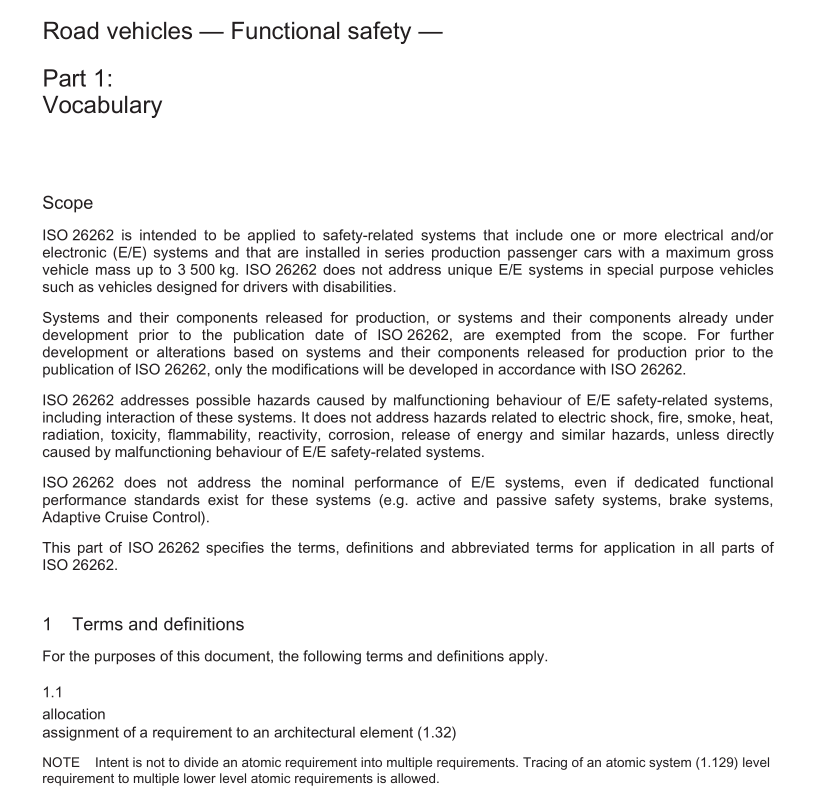c

BS ISO 26262-1 pdf download Road vehicles — Functional safety Part 1: Vocabulary
ISO 26262 is intended to be applied to safety-related systems that include one or more electrical and/orelectronic(E/E) systems and that are installed in series production passenger cars with a maximum grossvehicle mass up to 3 500 kg.ISO 26262 does not address unique E/E systems in special purpose vehiclessuch as vehicles designed for drivers with disabilities.
Systems and their components released for production,or systems and their components already underdevelopment prior to the publication date of lSO 26262,are exempted from the scope. For furtherdevelopment or alterations based on systems and their components released for production prior to thepublication of lSO 26262, only the modifications will be developed in accordance with ISO 26262.
ISO 26262 addresses possible hazards caused by malfunctioning behaviour of E/E safety-related systems,including interaction of these systems. It does not address hazards related to electric shock, fire,smoke, heat,radiation,toxicity, flammability,reactivity, corrosion, release of energy and similar hazards,unless directlycaused by malfunctioning behaviour of E/E safety-related systems.
ISO 26262 does not address the nominal performance of E/E systems,even if dedicated functionalperformance standards exist for these systems (e.g. active and passive safety systems, brake systems,Adaptive Cruise Control).
This part of lSO 26262 specifies the terms, definitions and abbreviated terms for application in all parts oflso 26262.
1 Terms and definitions
For the purposes of this document, the following terms and definitions apply.
1.1
allocation
assignment of a requirement to an architectural element (1.32)
NOTEIntent is not to divide an atomic requirement into multiple requirements. Tracing of an atomic system (1.129) levelrequirement to multiple lower level atomic requirements is allowed.
1.2
anomaly
condition that deviates from expectations,based,for example,on requirements,specifications,designdocuments, user documents, standards, or on experience
NOTE Anomalies can be discovered,among other times,during the review (1.98),testing (1.134),analysis,compilation, or use of components (1.15) or applicable documentation.
1.3
architecture
representation of the structure of the item (1.69) or functions or systems (1.129) or elements (1.32) thatallows identification of building blocks, their boundaries and interfaces, and includes the allocation (1.1) offunctions to hardware and software elements
1.4
assessment
examination of a characteristic of an item (1.69) or element (1.32)
NOTE A level of independence (1.61) of the party or parties performing the assessment is associated with eachassessment.
1.5
audit
examination of an implemented process1.6
Automotive Safety Integrity LevelASIL
one of four levels to specify the item’s (1.69) or element’s (1.32)necessary requirements of lS0 26262 andsafety measures (1.110) to apply for avoiding an unreasonable residual risk (1.97), with D representing themost stringent and A the least stringent level
1.7
ASIL decomposition
apportioning of safety requirements redundantly to sufficiently independent elements (1.32), with the objectiveof reducing the ASiL (1.6) of the redundant safety requirements that are allocated to the correspondingelements
1.8
availability
capability of a product to be in a state to execute the function required under given conditions, at a certaintime or in a given period,supposing the required external resources are available
1.9
baseline
version of a set of one or more work products,items (1.69) or elements (1.32) that is under configurationmanagement and used as a basis for further development through the change management process
NOTESee lSo 26262-8:2011,Clause 8.
1.10
branch coverage
percentage of branches of the control flow that have been executedNOTE 1100 % branch coverage implies 100 % statement coverage (1.127).
NOTE2 An if-statement always has two branches – condition true and condition false – independent of the existence ofan else-clause.
1.11
calibration data
data that will be applied after the software build in the development process
EXAMPLE Parameters (e.g. value for low idle speed,engine characteristic diagrams); vehicle specific parameters(adaptation values) (e.g .limit stop for throttle valve); variant coding (e.g. country code, left-hand/right-hand steering).
NOTE Calibration data cannot contain executable or interpretable code.









